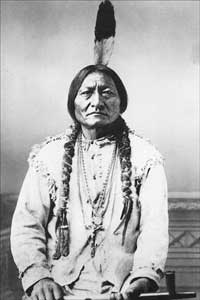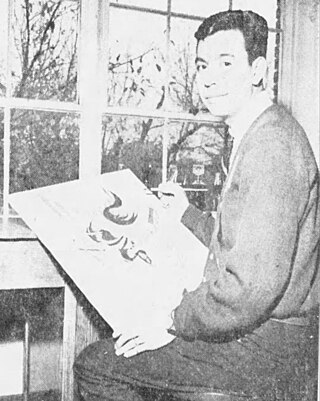Related Research Articles

The Crow, whose autonym is Apsáalooke, also spelled Absaroka, are Native Americans living primarily in southern Montana. Today, the Crow people have a federally recognized tribe, the Crow Tribe of Montana, with an Indian reservation, the Crow Indian Reservation, located in the south-central part of the state.

The Lakota are a Native American people. Also known as the Teton Sioux, they are one of the three prominent subcultures of the Sioux people, with the Eastern Dakota (Santee) and Western Dakota (Wičhíyena). Their current lands are in North and South Dakota. They speak Lakȟótiyapi—the Lakota language, the westernmost of three closely related languages that belong to the Siouan language family.

The Sioux or Oceti Sakowin are groups of Native American tribes and First Nations people from the Great Plains of North America. The Sioux have two major linguistic divisions: the Dakota and Lakota peoples. Collectively, they are the Očhéthi Šakówiŋ, or "Seven Council Fires". The term "Sioux", an exonym from a French transcription ("Nadouessioux") of the Ojibwe term "Nadowessi", can refer to any ethnic group within the Great Sioux Nation or to any of the nation's many language dialects.

A tipi or tepee is a conical lodge tent that is distinguished from other conical tents by the smoke flaps at the top of the structure, and historically made of animal hides or pelts or, in more recent generations, of canvas stretched on a framework of wooden poles. The loanword came into English usage from the Dakota language and Lakota language.

The Pine Ridge Indian Reservation, also called Pine Ridge Agency, is an Oglala Lakota Indian reservation located in the U.S. state of South Dakota, with a small portion of it extending into Nebraska. Originally included within the territory of the Great Sioux Reservation, Pine Ridge was created by the Act of March 2, 1889, 25 Stat. 888. in the southwest corner of South Dakota on the Nebraska border. It consists of 3,468.85 sq mi (8,984 km2) of land area and is one of the largest reservations in the United States.

Lakota, also referred to as Lakhota, Teton or Teton Sioux, is a Siouan language spoken by the Lakota people of the Sioux tribes. Lakota is mutually intelligible with the two dialects of the Dakota language, especially Western Dakota, and is one of the three major varieties of the Sioux language.

The Hunkpapa are a Native American group, one of the seven council fires of the Lakota tribe. The name Húŋkpapȟa is a Lakota word, meaning "Head of the Circle". By tradition, the Húŋkpapȟa set up their lodges at the entryway to the circle of the Great Council when the Sioux met in convocation. They speak Lakȟóta, one of the three dialects of the Sioux language.

The Brulé are one of the seven branches or bands of the Teton (Titonwan) Lakota American Indian people. They are known as Sičhą́ǧu Oyáte —Sicangu Oyate—, Sicangu Lakota, or "Burnt Thighs Nation". Learning the meaning of their name, the French called them the Brûlé. The name may have derived from an incident where they were fleeing through a grass fire on the plains.

The Rosebud Indian Reservation is an Indian reservation in South Dakota, United States. It is the home of the federally recognized Rosebud Sioux Tribe, who are Sicangu, a band of Lakota people. The Lakota name Sicangu Oyate translates as the "Burnt Thigh Nation", also known by the French term, the Brulé Sioux.

The Oglala are one of the seven subtribes of the Lakota people who, along with the Dakota, make up the Očhéthi Šakówiŋ. A majority of the Oglala live on the Pine Ridge Indian Reservation in South Dakota, the eighth-largest Native American reservation in the United States.
Theresa B. "Huck" Two Bulls was an attorney, prosecutor and politician in the United States and the Oglala Sioux Tribe. In 2004 she was elected as Democratic member of the South Dakota Senate, representing the 27th district, the first American Indian woman to be elected to the state legislature. She served until 2008. That year Two Bulls was elected as president of the Oglala Sioux Tribe of the Pine Ridge Reservation, the second woman to serve in this position. She served one term, which was two years.

The Yankton Sioux Tribe of South Dakota is a federally recognized tribe of Yankton Western Dakota people, located in South Dakota. Their Dakota name is Ihaƞktoƞwaƞ Dakota Oyate, meaning "People of the End Village" which comes from the period when the tribe lived at the end of Spirit Lake just north of Mille Lacs Lake.

Ledger art is narrative drawing or painting on paper or cloth, predominantly practiced by Plains Indian, but also from the Plateau and Great Basin. Ledger art flourished primarily from the 1860s to the 1920s. A revival of ledger art began in the 1960s and 1970s. The term comes from the accounting ledger books that were a common source of paper for Plains Indians during the late 19th century.
The culture of the U.S. state of South Dakota exhibits influences from many different sources. American Indians, the cultures of the American West and Midwest, and the customs and traditions of many of the state's various immigrant groups have all contributed to South Dakota art, music, and literature.

Arthur Douglas Amiotte is an Oglala Lakota Native American painter, collage artist, educator, and author.
The Rapid City Indian Health Service Hospital formerly known as The Sioux San Hospital is an Indian Health Service hospital located in Rapid City, South Dakota. It was built in 1898 as a boarding school for Native Americans and turned into a sanitarium in 1933.
St. Joseph's Indian School is an American Indian boarding school, run by the Congregation of the Priests of the Sacred Heart just outside the city of Chamberlain, South Dakota, on the east side of the Missouri River. The school, located in the Roman Catholic Diocese of Sioux Falls and named after Saint Joseph, is operated by a religious institute of pontifical right that is independent of the diocese. The school is within two hours of three reservations of the Lakota people: the Cheyenne River Indian Reservation, the Lower Brule Indian Reservation and the Crow Creek Indian Reservation, whose children comprise the majority of students at the school. The Akta Lakota Museum and Cultural Center is located on the campus and is owned by the school.

SD Nelson was born Stephen D. Nelson at the United States Army Station Hospital in Fort Knox, Kentucky. He is an American illustrator and author of many children's books including Black Elk’s Vision, Gift Horse, The Star People and Buffalo Bird Girl. Nelson's work has been praised as “stirring, inspirational, original and beautifully illustrated”. His books have received the American Indian Library Association – Honor Book Award 2016.; the Spur Award – Western Writers of America 2004, 2006 ; the Notable Book Award – American Library Association 2001, 2011, and the Bluebonnet Master List Award – Texas Library Association 2011.

The Aktá Lakota Museum & Cultural Center is a private, non-profit educational and cultural outreach program of St. Joseph's Indian School, Chamberlain, South Dakota, United States. The museum was established in May 1991 to honor and preserve the Lakota culture for the students at St. Joseph’s Indian School and to foster among people who visit an appreciation of the culture.

Andrew Standing Soldier was an Oglala Lakota artist from the United States, known for his depictions of contemporary Native life. His often-humorous narratives scenes in murals, watercolors, paintings, and book illustrations.
References
- 1 2 3 4 Campbell County (WY) Government. "1990-1999 obits (PDF)".
- 1 2 "Amiotte, Emma 1914- in Art & Artists Files in the Smithsonian Libraries' Collections". www.sil.si.edu. Retrieved 2022-08-01.
- 1 2 3 "Legacy Emma Amiotte - SD Hall of Fame Programs". sdexcellence.org. Retrieved 2022-08-01.
- 1 2 "1998: 50 Works for 50 Years". South Dakota State University. Retrieved 2022-08-01.
- ↑ South Dakota SHPO (2004). Black Hills Model Home: Wilkins Home (National Register of Historic Places Registration Form) (PDF). United States Department of the Interior National Park Service. p. 12.
- ↑ Chasing Hawk, Ernestine (2016-08-03). "Tribes reclaim Sioux San land". Native Sun News Today. Retrieved 2022-08-01.
- ↑ Chasing Hawk, Ernestine (August 8, 2016). "Native Sun News: Tribes reclaim land at former Indian boarding school in Rapid City". Indianz. Retrieved 2022-08-01.